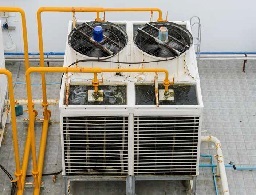by
Robert Garment, Executive Editor | October 21, 2016
From the October 2016 issue of HealthCare Business News magazine
Visit any health care facility at 3 in the morning and you will probably find that the CTs and MRs are idle, but they are not at rest. They’re still running, and in fact, they never stop running. Or more precisely, the equipment that helps keep the liquid helium liquid and the computers cool is running. Yet the chiller is a very underappreciated part of many medical systems. The name itself is a little misunderstood as well. The job of the chiller is to remove heat from a system, not to generate cold. The medium that removes the heat from MRs, proton cyclotrons, linacs and other “big iron” is plain, simple water, or more typically, a water/glycol mixture (glycol is basically an antifreeze).
With the large spike in helium prices in recent years that may continue, keeping the helium from boiling off is more important than ever, because helium losses can cost thousands of dollars a day. But the most critical contribution of the chiller is helping ensure essential medical services are not interrupted. What does it take to keep a chiller running smoothly? We asked the people who know.
Preventive maintenance is king
There’s a famous saying in the real estate business that the three most important things you need to know are: location, location, location. For chillers, it’s a little different. The three most important things are: preventive maintenance, preventive maintenance, preventive maintenance. That was the universal opinion of those interviewed for this report.
Ronnie Taylor, president of SRS, Inc./ SVSR, Inc., says, “we recommend that any chiller has at least two PMs a year.” And that was the consensus view, with many people saying that, ideally, quarterly PMs were best. In some cases, where the MR is working full time, if not overtime, monthly PMs could be in order.
Martin King, CEO of Legacy Chillers, says that having a clear maintenance plan is one thing, but “the trick is to keep the schedule of PMs you’ve set up. Don’t let it slip. If you miss a PM, that’s when trouble can start brewing.”
According to Jim Nestel, manager of projects and installations, Hitachi Medical Systems America, here’s what you should ask the service technician doing your PM to do:
• Clean the condenser coils to maintain maximum air flow for cooling.
• Check all fluid levels.
